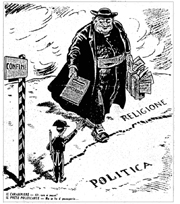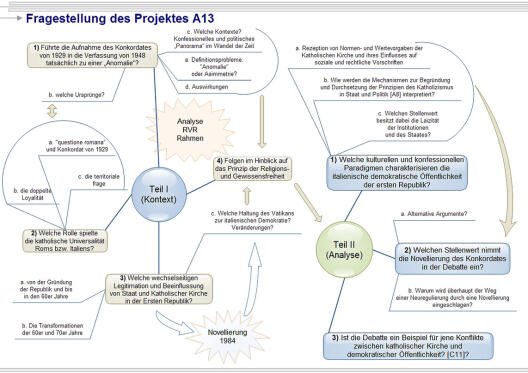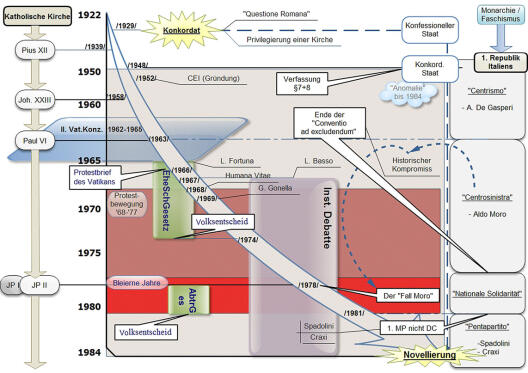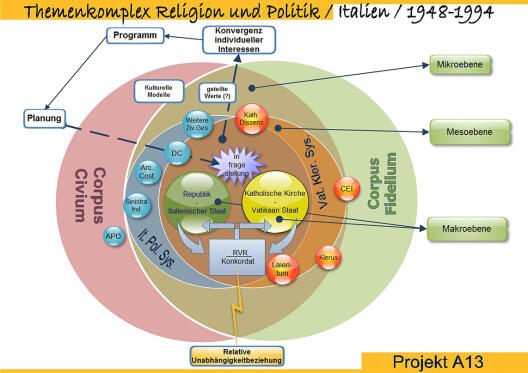(A13) Political Modernity and the Catholic Church in Italy’s “First Republic”: The Political and Cultural Controversy about the Amendment of the Concordat

Description of the object of research
During the 1950s, a debate arose on the contradiction (the so-called “anomaly”) between the constitutional principle of the freedom of conscience and religion (article 8) and the continuing privilege of the Catholic Church by means of the acceptance of the 1929 Lateran Treaty into the Italian republican constitution (article 7). Starting from the analysis of this debate, the core focus of the project A13 is the historical investigation of the reform debate on the amendment of the concordat between the Italian State and the Vatican in the years from 1948 to 1984.
The project’s point of origin is the observation that in the scientific reception of and accounting for the forty-year reform process, most (historical) studies concentrate mainly on the institutional dimension of challenging the concordat or on the parliamentary and diplomatic development of the amendment. Thus, the project A13 focuses increasingly on society’s mesolevel. In addition to the institutional political players, autonomous groups (also Catholic ones) and groups that take a critical stance towards the parties and the Church hierarchies will also be investigated as not only activists such as the Partito Radicale, communists, socialists and anti-clericals appeared as protagonists of the debate, but also large parts of the Catholic democratic public (ACLI, CISL, FUCI and the “groups of dissent”). Their different and alternative interpretations of the system to enforce normative provisions of the Catholic Church, existing until 1984, and their critical stance on the state’s independence of the Vatican will be analysed in the project.
Questions and approach
The project’s first part deals with the interdependency of religion and politics in the Italian Republic until 1984. The following questions (amongst others) are to be answered here: Did the acceptance of the 1929 concordat into the constitution of 1948 in fact result in an “anomaly”? What are the consequences that can be observed regarding the principle of the freedom of conscience and religion? Which reciprocal legitimation and influence of the state and the Catholic Church can be identified? What role does the Catholic universality of Rome or of Italy respectively play in this? In what ways did the stance of the Vatican to the Italian democracy change?

The second part of the project deals specifically with the positions, opinions and activities of society’s mesolevel. Here, not only is it to be revealed how the spectrum of positive and negative criticism of the concordat as a regulatory instrument of the Catholic Church’s normative role in the republic has become more differentiated (What significance did the amendment of the concordat have in the debate? Why was a new regulation through amendment tackled in the first place?), but it is also to be emphasised how, between 1948 and 1984, the mechanisms to substantiate and enforce the Catholic principles in the state and in politics were interpreted, and how the norms and values required by the Catholic Church as well as their influence on social and legal regulations were received at the mesolevel. Important questions in this context are: which cultural and confessional paradigms characterised the Italian democratic public during this period? What was the significance of the institutions’ and the state’s laïcité in this? To what extent can this be seen as an example of a conflict between the Catholic Church and the democratic public?
Sources
So far, work in the project is based on the following sources: newspapers, journals, speeches, posters, flyers and other publications and media produced by parties, movements, groups and individual protagonists of the debate. The most important documents were obtained from the archives of Guido Gonella at the Istituto Luigi Sturzo (Rome) and from the collections of Gerardo Bruni, Lelio Basso and Ada Alessandrini at the Fondazione Lelio e Lisli Basso – Issoco (Rome) during a research trip in July 2009. They have already been analysed. Other documents come from the Italian parliament (parliamentary files, commission records, preparatory materials, investigations, commissioned studies etc.).
In two other planned research trips, the inventories of the Istituto Paolo VI in Brescia, of the Archivio di Stato di Parma (Fondo Archivio privato Casaroli) and of the Fondazione per le scienze religiose Giovanni XXIII in Bologna (Fondo Vaticano II, Fondo lettere pastorali) will be examined.
Surrent state of our research
The project’s findings will be summed up as a professorial dissertation in monographic form. The subproject A13 was started in January 2009 and at the evaluation of the project in April 2010, an adequate preliminary outline could already be submitted which continues to serve as the most important point of reference for the operationalisation of the entire project.
In the monograph, thus, the social, political and economic developments in the Italian Republic will first be reconstructed by a periodisation highlighting the parallelism of the republican government coalitions’ terms of office and of the papacies from Pius XII to John Paul II. On this basis, the project’s research results will be presented regarding the political, civil societal and theological reflections on laïcité (the actual key aspect of the Italian public debate about the concordat since the 1950s) as possible central ideas of a democratic model.

Monograph
The tedious process of amending the concordat between the Italian state and the Vatican (1948-1984) forms the investigation’s backdrop. A periodisation emerges from this that is mirrored in the work’s tripartition.
Starting from a system theoretical approach influenced by both Talcott Parson and Niklas Luhmann, the amendment can be seen not only as a diachronic point of reference of the project, but primarily as an example of a republican political process in which the new legal interpretation of the concordat forms the phase of the establishment of a collectively binding decision. This phase will be analysed in the third part (1969-1984) of the work, following the analysis in the second part (1958-1978) of the setting up of the propositions of decision, i.e. of the various forms of the collective reception and challenging of the prevailing relationship of religion and politics, and their circumstances in the first part (1948-1958).
From a general system theoretical perspective, the concordat will already in the first part of the work be perceived as the regulative element of the “relative relationship of independence” between the central Italian functional systems in religion and politics: the Italian Republic and the Catholic Church. In contrast to initial observations, my source analysis so far reveals that the real focus of social interest in the 1960s and 1970s was not solely on the legal redefinition of the Republican religion constitutional framework, but particularly on the political, theological and civil societal definition of laïcité with regard to the concordat as a regulative instrument between the Church and the state.
Projecting Luhmann’s model of democracy onto this debate which forms the main element of analysis of the monograph’s second part, that same political “planning” of the democratic public can be detected in it that, according to Luhmann, is itself to be received by the “political administration” as an “expectation” of the political subsystem. In order to remain within this theoretical framework, the formation and the development of the regulative-relational regime between the republic and the Catholic Church, its challenging and redefinition, and the corresponding conflicts and conflict resolutions will be analysed in the three parts of the monograph by means of a differentiation of the Italian social system into a microlevel, a mesolevel and a macrolevel.

As primary reference systems, the Italian Republic and the Catholic Church, both in the entirety of their state and ecclesiastical institutions and structures respectively, represent the macrolevel of the Italian social system.
Of particular importance in this work, however, is the mesolevel as it is right here that the Italian political subsystem is formed as a result of the interaction of individuals. It consists of an extensive network of parties, civil societal structures as well as (a)confessional, informal and non-Catholic organisations that are in part very strongly influenced by the individual’s often coinciding double role at the microlevel as a republican citizen (corpus civium) on the one hand and a member of the Catholic religious community (corpus fidelium) on the other hand.
Another differentiation of the mesolevel into a “party system” and a “clerical system” is thus required. It first of all serves the purpose of an improved rendering of the different positions in the debate on the relationship of religion and politics in a democratic system – that is, about the laïcité of individuals and institutions, about religious freedom and cultural pluralism as well as about the role of the Catholics in politics and about the value of Italian democracy for the Catholic Church.
Operationally, this means that a diachronic contextualisation of the developments of the two functional systems (state/Church) is provided at the beginning of each main part. Furthermore, all developments of the so-called “environment” are expounded and discussed in detail. Due to the parallel structuring of the analysis of the amendment of the concordat as a political process, each part of the monograph focuses on a different level of the Italian social system. The central chapters of each of the three sections are dedicated both to the investigation of the field of tension between religion and politics and to the adaptation of the republic and the Church to the challenges of the environment.
Other publications of project findings
Even before the publication of the monograph, some key topics of the project will be dealt with in various forms and presented until mid-2012. For example, the changes and pluralisations of the value paradigms in Italy and Germany during the investigated key period (1965-1978) have already been the focus of a miscellany on the conservative trends of the 1970s (all links are in German) edited by the head of the project, Dr. Max Livi. The Italian social system’s persistent asynchrony between the macrolevel and the mesolevel as regards the reflection of civil rights as well as its impact on the reforms of the religious political arrangement is currently under investigation in an essay. In addition, transformation processes and crisis phenomena of the “long 1970s” will be dealt with on the occasion of an international symposium in November 2011. The topic of “laïcité” is in the focus of another miscellany which will investigate the changes in the semantics and significance of the term of laïcité taking place since the 1970s.
Miscellany:
Lecture at the Conflicts study group on the topic: When conflicts hide alliances: the case of Dino Boffo and the new (Church) political conditions in Italy [in German]
Coordination of the study group: The (long) 70s
Essay for the column Ansichtsache: Mit der katholischen Kirche gegen den italienischen Staat?

